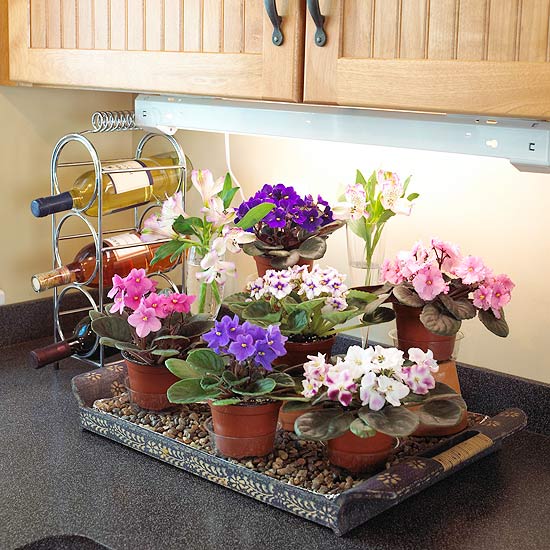






The brightest grow lights are high-intensity discharge (HID) lights. They can be installed anywhere in your home, garage, or greenhouse to supplement existing light, and they can serve as the sole source of light for your plants.
These bulbs pass electricity through a glass or ceramic tube containing a mixture of gases. The blend of gases determines the color of the light given off by each type of lamp. HID lights are twice as efficient as fluorescent lamps; one 400-watt HID lamp emits as much light as 800 watts of fluorescent tubing. All HID lights can run on regular 120-volt household current but they require special fixtures with ballasts.
Learn more tips to figuring out your plants' indoor light needs!
Shop for grow lights.
There are two categories of HID lamps: metal halide (MH) and high-pressure sodium (HPS). Both emit a much more intense light than fluorescent bulbs, which also pass electricity through a gas-filled tube.
MH bulbs emit light that's strongest at the blue end of the spectrum. It's a stark, cool white light that produces compact, leafy growth. Because the light does not distort the colors of the plants and people it illuminates, this type of plant grow light is a good choice for a light display in a living area.
Agrosun gold halide bulbs are color-corrected to give off more red/orange light than regular metal halides. This helps boost flowering in addition to supporting compact foliar growth. Halide bulbs should be replaced about once a year.
HPS bulbs last slightly longer; they should be replaced every 18 months. They emit light strong at the red/orange end of the spectrum, which promotes flowering. However, HPS lighting may also produce leggy growth unless used together with daylight or a metal halide system.
If your goal is lots of bloom, use high-pressure sodium lamps, but be advised: Their light has a red/orange cast that distorts the colors of everything they illuminate. This plant grow light is not flattering in a living room; everyone looks slightly jaundiced.
Grow Light Test Garden Tip: You can use both high-pressure sodium and metal halide bulbs in a single location, but a metal halide bulb cannot be used in a high-pressure sodium fixture, and vice versa. HPS ballasts include an igniter and MH ballasts do not. If you have multiple fixtures, consider a combination of HPS and MH systems. If you have only one fixture, you can use a conversion bulb, using metal halide to promote foliage growth, then switching to a conversion high-pressure sodium bulb to encourage flowering.
High-intensity fluorescent bulbs are also an excellent choice. Fixtures resemble those of HID bulbs, but they are less expensive, and cool and warm bulbs are available that fit in the same ballast. Choose according to which light is more appealing to your eye.
Traditional fluorescent tubes are the most economical choice if you're going to use grow lights. They can be used in inexpensive shop light fixtures or multitier growing carts.
The light produced by fluorescent tubes is much less intense than the other choices, so you are more limited in what you can grow. If you're just trying to supplement natural light rather than replace it, fluorescent light may be a good option.
Fluorescent tubes come in cool, warm, or full-spectrum. Light from cool tubes has a blue cast, while warm tubes emit a pink/white light. Full-spectrum tubes closely approximate the color of natural daylight. Full-spectrum bulbs are a bit more expensive but many growers consider them worth the price since the color of the light doesn't distort the color of your plants.
Less light is emitted from the ends of the fluorescent tubes than from the center. Plants with lower light needs should be placed under the 3 inches of tube at either end of the fixture.
Fluorescent tubes should be replaced every 18 months if they are being used approximately 16 hours per day.
Once you've decided which kind of plant grow light you want, it's time to decide how big a bulb you need for the space you have.
First, determine how much space you need to illuminate. As a rule, you want 20 to 40 watts per square foot. Then divide the wattage of your bulb by 20 (such as 1,000 ÷ 20 = 50), then divide the wattage of your bulb by 40 (1000 ÷ 40 = 25).
The answer gives you the extremes of your light intensity range. With one 1,000-watt system, you can light between 25 and 50 square feet of interior landscape, depending on the plants and their light requirements.
Adjust your setup as you observe how well your plants grow, and increase or decrease the intensity of the light accordingly. This can be done by shifting the placement of your plants or light fixture so they are closer together or farther apart, but not by changing the bulb in your lamp to a bulb with more watts.
Each lamp is designed for a specific wattage and a 400-watt bulb cannot operate safely in a 250-watt system.
Copyright © www.100flowers.win Botanic Garden All Rights Reserved